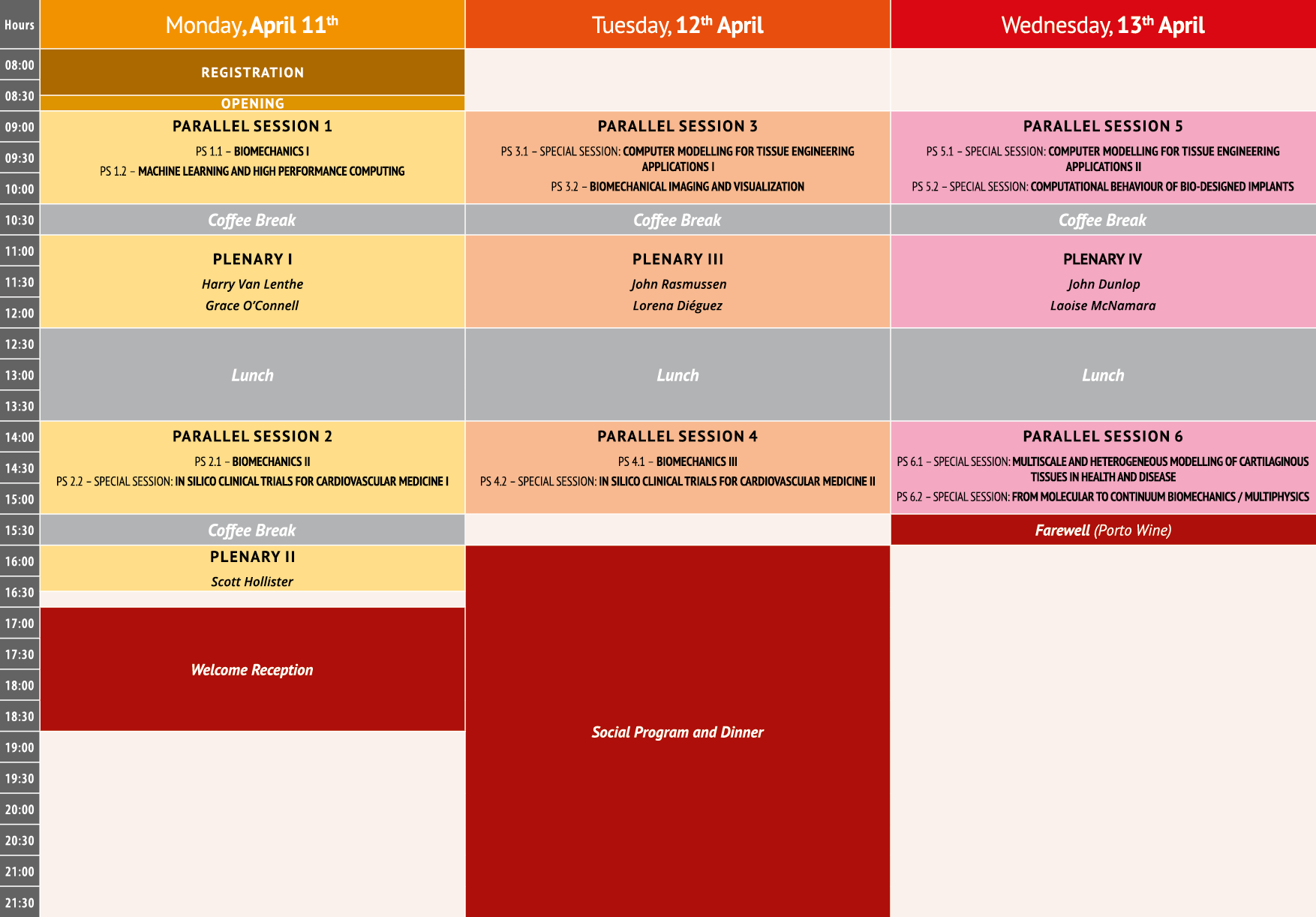
IX International Conference on
Computational Bioengineering
11 - 13 April 2022
Instituto Superior Técnico | Lisbon | Portugal
PROGRAM
> Invited Speakers
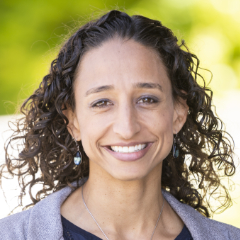
Grace O’Connell
University of California, Berkeley, USA
Presentation Title:
"3D modeling of the intervertebral disc: direct relationship between tissue composition and model parameters"
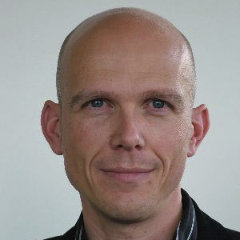
Harry Van Lenthe
KU Leuven, Belgium
Presentation Title:
"Computational biomechanics for clinical decision making. Have we reached it?"
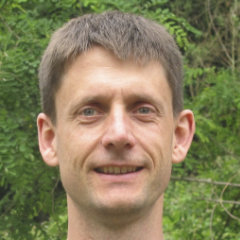
John Dunlop
University of Salzburg, Austria
Presentation Title:
"Modelling the role of curvature on tissue patterning and growth"
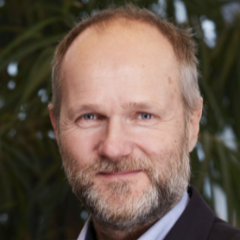
John Rasmussen
Aalboorg University, Denmark
Presentation Title:
"Statistical biomechanical models: from individuals to populations"

Laoise McNamara
National University of Ireland, Ireland
Presentation Title:
“Computational modelling to advance understanding of how medical device design influences the cellular biophysical environment”
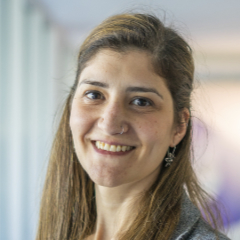
Lorena Diéguez
INL - International Iberian Nanotechnology Laboratory, Portugal
Presentation Title:
“Microfluidics and nanotechnology: towards advanced organ-on-a-chip systems”

Scott Hollister
Georgia Tech, USA
Presentation Title:
"Finite Element Continuum Damage Modeling of Skin Over Auricular Implants"
> Mini-symposia
Protective Material Development for Sport Equipment
Dominique Pioletti, EPFL, Switzerland
Naser Nasrollahzadeh, EPFL, Switzerland
> Click Here to read Special Session description
Despite increase of protective helmet usage over the last 20 years, the number of severe head injuries did not decrease and reportedly sport-related concussions continue to rise. Innovative development of protective head gears is highly required to reduce the risk of traumatic brain injury in contact/combat and high-speed sports. Given remarkable improvement in design of customized helmets for different sports such as Ice-hockey, American football and cycling, their performance is not at the level we would expect to efficiently protect athletes from brain injury in case of impact incidences. We strongly believe that the recent innovations obtained in the field of dissipative materials could significantly improve the performance of helmets if integrated with recently developed technologies based on buckling cone, air damper, buckling beam and multi-directional impact protection systems. Accordingly, the symposium would focus on the development of energy absorber materials and novel structural design strategies for protective helmets to optimize transmission of force in different impact speeds.
Data-driven Biomaterials and Biomechanics
Miguel Castilho, TU Eindhoven, The Netherlands
Miguel Bessa, Delft Univ., The Netherlands
> Click Here to read Special Session description
In silico clinical trials are the future of medicine and virtual testing and simulation are the future of medical engineering. Usage of computational platform will provide lower costs and less required time for developing new models of medical devices and drugs. In this mini-symposium some papers with multiscale modeling and artificial intelligence application of cardiovascular disease which consider a comprehensive list of patient specific features as genetic, biological, pharmacologic, clinical, imaging and cellular aspects will be presented. The aim is to avoid adverse effects, drug interactions, preventing sudden cardiac death, shortening time between the drug treatment commencement and the desired result. It will open a new avenue for research and commercial projects to better recognize in silico paradigm inside medical device and drug industry.
In Silico Clinical Trials for Cardiovascular Medicine
Nenad Filipovic, University of Kragujevac, Serbia
> Click Here to read Special Session description
In silico clinical trials are the future of medicine and virtual testing and simulation are the future of medical engineering. Usage of computational platform will provide lower costs and less required time for developing new models of medical devices and drugs. In this mini-symposium some papers with multiscale modeling and artificial intelligence application of cardiovascular disease which consider a comprehensive list of patient specific features as genetic, biological, pharmacologic, clinical, imaging and cellular aspects will be presented. The aim is to avoid adverse effects, drug interactions, preventing sudden cardiac death, shortening time between the drug treatment commencement and the desired result. It will open a new avenue for research and commercial projects to better recognize in silico paradigm inside medical device and drug industry.
> Click Here to close Special Session description
Computer Modeling for Tissue Engineering Applications
Sara Checa, Charité Berlin, Germany
Pasquale Vena, Politecnico di Milano, Italy
> Click Here to read Special Session description
The session would focus on the development and application of computer models for the design of scaffolds for tissue engineering applications. The use of computer models to understand the principles behind scaffold-supported regeneration and to optimize the design of those scaffolds to best support regeneration would be covered.
Contributions addressing innovative methods for In-silico twins of BTE scaffolds, micro Computed-Tomography - based models as well as design based on data analyses (AI-based algorithms) are welcome. Manufacturing techniques based on 3D-printing technologies and material selections informed by in-silico models are also of interest for this symposium.
> Click Here to close Special Session description
Bone Mechanobiology: Experimental and Computational Assessment Across the Scales
Peter Pivonka, Queensland University of Technology, Australia
Javier Martínez-Reina, University of Seville, Spain
> Click Here to read Special Session description
There has been an increasing interest in the computational modeling of various aspects of bone biology including the mechanobiology of structural adaptation as well as the cellular and biochemical underpinnings of bone tissue remodeling. In vivo experimentation with bone tissue is very expensive and a deeper understanding of basic bone biology is required in order to improve treatment methods for bone diseases such as osteoporosis and various forms of bone metastases. Bone tissue is multiscale in nature and needs to be maintained by homeostatic feedback processes regulated by cells such as osteocytes, osteoblasts and osteoclasts. These processes act across large length and time scales, which are difficult to identify based on experiments alone. Developing multiscale computational approaches together with new experimental data obtained applying latest imaging technologies allow to integrate and then interrogate these feedback processes.
This mini-symposium brings together bioengineers, biologists and mathematicians whose common goal is the advancement of current understanding of bone tissues behavior and function. We are looking for new innovative assessment strategies including multiscale computational modeling and high resolution imaging technologies. Topics will range from musculoskeletal models describing bone-muscle interactions during daily activities such as walking or running, to joint mechanics, to micromechanical models for estimation of tissue mechanical properties, to tissue remodeling and adaptation models, to cellular models describing the complex cell interactions taking into account biochemical and biomechanical regulatory factors.
> Click Here to close Special Session description
From Molecular to Continuum Biomechanics
Stéphane Avril, Mines Saint-Etienne, France
Christian Hellmich, TU Wien, Austria
> Click Here to read Special Session description
The mini-symposium will focus on recent advances in the mechanics of biomolecules (including proteins, genes, cytoskeletons, etc.) and on how these advances contribute to the generation of knowledge and information concerning the mechanobiology of cells, tissues, and organs.
The mini-symposium would bring together mechanicians, bioengineers, biologists and mathematicians whose common goal is to decipher, across the scales, how forces are transmitted through biomolecules and how they influence the biological functions of cells and their interactions with the extracellular matrix.
Contributions addressing innovative mathematical methods or presenting original experimental data will be welcome. Applications of mechanical models to molecular and cellular mechanobiology are also of interest.
> Click Here to close Special Session description
Computational Behavior of Bio-designed Implants
António Ramos, DEM - University of Aveiro, Portugal
Michel Mesnard, I2M, University of Bordeaux, France
> Click Here to read Special Session description
The implant's design involves a complex task to promote bone integration and, at the time, Bio-design allows introducing nature concepts into the implant functioning.
With this objective, the use of computational models to understand and improve the integration, design the surface and predict the bone-implant interface behavior is a important tool to supports the concepts.
These new concepts with complex surfaces based on additive manufacturing bring new challenges in digital simulation and in silico models to understand bone implant interface as well as in the experimental validation.
> Click Here to close Special Session description
Multiscale and Heterogeneous Modelling of Cartilaginous Tissues in Health and Disease
Jérôme Noailly, Universitat Pompeu Fabra, Spain
Liesbet Geris, Université de Liège, Belgium
> Click Here to read Special Session description
Cartilaginous tissue degeneration uses to be linked to highly prevalent joint disorders, such as osteoarthritis or intervertebral disc degeneration, among others. The slow turnover of these tissues and the sensitivity of the embedded cells to a plurality of biochemical, nutritional and mechanical cues make the degeneration processes to evolve slowly and silently, over decades. Once symptoms appear, the dynamics of cartilaginous tissue degeneration has acquired a strong inertia and has become increasingly multifactorial, hindering both proper patient stratification and targeted curative therapies. Accordingly, there is a tremendous need to capture the mechanisms that drive the biological catabolic shifts of cell activities that eventually lead to cartilage destruction, to support the identification of (i) personalized early biomarkers and risk factors, and of (ii) therapeutic targets. Given the complexity and the multifactorial nature of the interactions that drive these mechanisms at different scales in organ contexts, and the difficulty to measure these interactions in situ, computer models and simulations provide a unique opportunity to better understand and tackle cartilage degeneration in musculoskeletal disorders. Accordingly, this mini-symposium aims to present and discuss the latest research efforts in cartilage and joint modelling through the scales, covering biology, data- and knowledge-driven and biomechanical computational modelling. The Mini-Symposium is directly supported by the H2020 ITN-ETN project Disc4All.
> Click Here to close Special Session description
IDMEC © Copyright 2022. All Rights Reserved.
